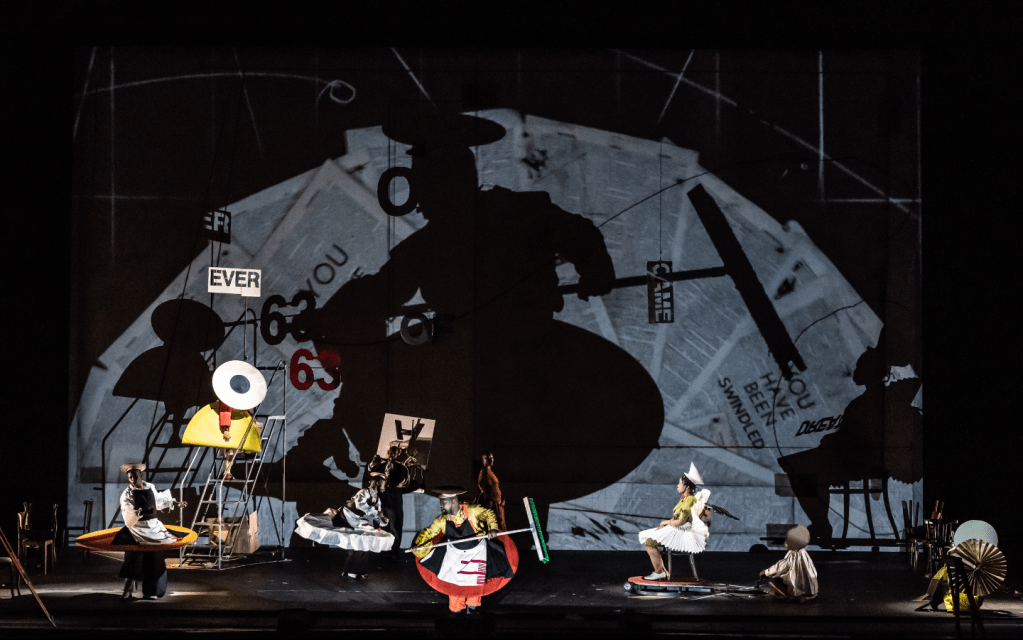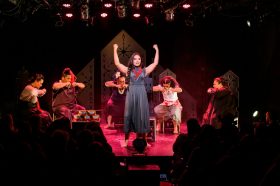To describe Sibyl as simply theatre or opera would be an understatement, as the production enthrals audiences with an eclectic, but harmonious, mixture of art forms. Occupying the same stage is everything from mesmerising dance to beautiful vocals, ominous shadow play, animated charcoal paintings and poetic verses that make the piece a sensory delight.
Ideated by South African artist William Kentridge, the performance is the closing show of Sydney Opera House’s 50th Birthday Festival. Sibyl is a befitting piece for the momentous occasion of change, as what makes it so special is that it breaks conventions by departing from the dominant, traditional Western operas.
It is split into two sections, including ‘Part 1: The Moment has Gone’, a short film accompanied by a male quartet led by Nhlanhla Mahlangu and pianist Kyle Shepherd. The film artistically portrays Kentridge’s process of making his charcoal animations, setting the mood and increasing our appreciation of ‘Part 2: Waiting for the Sibyl’. The second section is the spectacular main course of the show, made up of a chamber choir whose movements and colours are as arresting as their musical talents.
Both parts imbue native South African musical and cultural elements to powerfully capture fate’s painful unpredictability, evident in the creator’s inspiration, the Greek myth of the Cumaean Sibyl. Sibyls were oracles who made prophecies on oak leaves that the wind would muddle up, rendering it impossible to tell if specific futures were correct.
While the meaning is largely open to interpretation, this reviewer also sees it as a lament of hope and hopelessness in our world; the weight of raw emotions is powerfully felt across the audience. This can be attributed to the performance’s different visual and aural elements, both complementing and enhancing one another.
The highlight is the singers’ powerful renditions, who, despite performing in various Bantu languages, traverse barriers as the gravity of the music’s meanings and feelings is intensely conveyed. There is no sense of confusion, but rather it is refreshing to hear musical traditions that are both non-Western and aurally pleasing.
It is also technically impressive to hear the quartet and choir manoeuvre between different vocal techniques and qualities with such control, and which add layers of meaning – including soulful harmonies and transitions into smooth falsetto, reflecting hope as well as dissonance and ululating to express despair.
The stage production is the other highlight of the show, heightening the performance’s dramatic impact and being visually impressive. As the performers dance and move around with great presence, their often bright and complex clothing contributes to the stunning spectacle onstage. The stage pieces intensify the powerful feelings conveyed, reinforcing the imagery as meaningful symbols of the scenes.
The screen behind the action is also cleverly incorporated, both aesthetically as a backdrop filled with animations, and practically in displaying song translations. Ambiguous phrases such as ‘Wait again for better Gods’ and ‘Heaven is talking in a foreign tongue’ add further nuance and power to the piece.
Altogether, these perfected elements mean that the six scenes within ‘Waiting for the Sibyl’ are complex and detailed, yet poetic. From the frenzied search within a sea of papers and breaking chairs that signify inevitable loss, to the final hopeful scene that switches between a resonant deep male voice and an angelic female one, we are taken on a journey that leaves a lasting impression.
Read: Musical review: Miss Saigon, Sydney Opera House
A beautifully made piece that reflects a significant moment of change, Sibyl hopefully signifies a new era marked by innovatively different performances at the Sydney Opera House.
Sibyl
Concept and Direction: William Kentridge
Composition and Music Direction: Kyle Shepherd
Choral Composition, Associate Direction: Nhlanhla Mahlangu
Editing, Compositing: Žana Marović
Costume Design: Greta Goiris
Set Design: Sabine Theunissen
Lighting Design: Urs Schönebaum
Lighting Design Associate: Elena Gui
Sound Engineering: Gavan Eckhart
Cinematography: Duško Marović
Video Control: Kim Gunning
Piano: Kyle Shepherd
Vocalist, Dancer: Nhlanhla Mahlangu and Xolisile Bongwana
Dancers: Thulani Chauke, Teresa Phuti Mojela and Thandazile “Sonia” Radebe
Vocalists: Ayanda Nhlangothi, Zandile Hlatshwayo, Siphiwe Nkabinde and S’busiso Shozi
Sibyl by William Kentridge is performed from 2-4 November at Joan Sutherland Theatre, Sydney Opera House: tickets $25-$139.
This review is published under the Amplify Collective, an initiative supported by The Walkley Foundation and made possible through funding from the Meta Australian News Fund.





